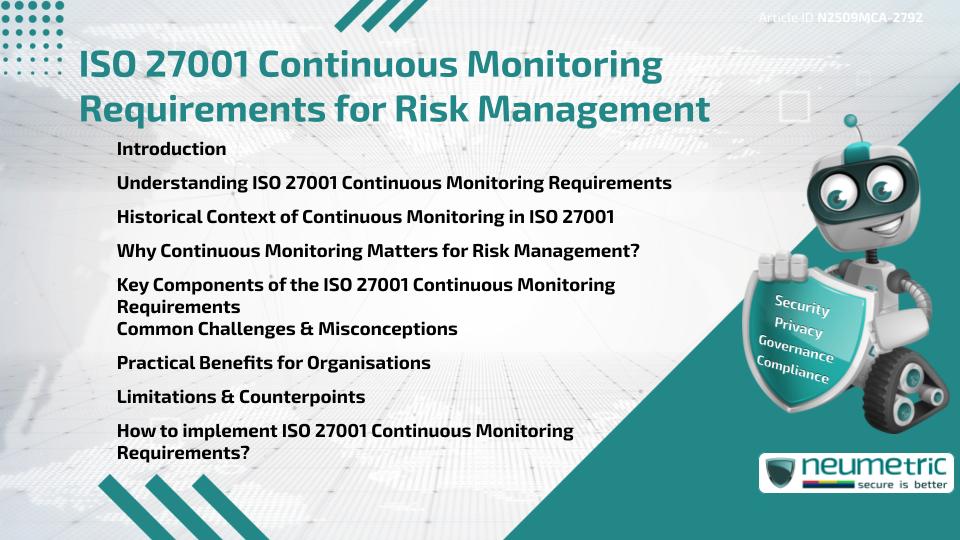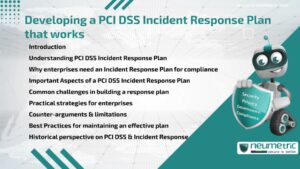Table of Contents
ToggleIntroduction
The ISO 27001 Continuous Monitoring requirements are a cornerstone of effective Risk Management & compliance under the Information Security Management System [ISMS]. Continuous Monitoring ensures that Risks are identified, assessed & addressed in real-time, allowing Organisations to adapt to evolving Threats & regulatory demands. For business leaders, understanding these requirements is essential for protecting Sensitive Information, maintaining compliance & building organisational resilience. This article examines their history, importance, key elements, challenges & benefits.
Understanding ISO 27001 Continuous Monitoring Requirements
ISO 27001 mandates that Organisations adopt Continuous Monitoring as part of their ISMS. Unlike one-off audits or periodic reviews, Continuous Monitoring provides ongoing oversight of controls, Risks & Vulnerabilities. This includes reviewing security events, updating Risk registers & monitoring compliance with Policies & regulations. The ISO 27001 Continuous Monitoring requirements ensure that businesses maintain a proactive, rather than reactive, security posture.
Historical Context of Continuous Monitoring in ISO 27001
Continuous Monitoring gained prominence with the rise of Cybersecurity Threats in the early 2000s. When ISO 27001 was first introduced in 2005, it emphasized regular reviews. Later revisions strengthened the need for continuous oversight to align with the growing sophistication of cyberattacks. Today, these requirements reflect lessons learned from decades of evolving security standards & the increasing need for real-time defense.
Why Continuous Monitoring Matters for Risk Management?
Without Continuous Monitoring, Organisations Risk overlooking Vulnerabilities that can be exploited quickly. The ISO 27001 Continuous Monitoring requirements help detect issues early, prevent incidents & ensure compliance with regulations. For business leaders, this translates into better Risk visibility, reduced downtime & enhanced trust with Customers & Stakeholders.
Key Components of the ISO 27001 Continuous Monitoring Requirements
- Risk Assessment updates: Regularly reviewing Risks & updating the Risk register.
- Monitoring controls: Checking that technical & organizational controls remain effective.
- Incident detection: Identifying anomalies, breaches or suspicious activity in real-time.
- Performance evaluation: Measuring the effectiveness of the ISMS against defined objectives.
- Management reviews: Senior leadership involvement in analyzing reports & making improvements. These components ensure that the organisation maintains a dynamic approach to security & compliance.
Common Challenges & Misconceptions
Some Organisations assume that annual audits fulfill monitoring requirements. However, the ISO 27001 Continuous Monitoring requirements go beyond audits by demanding regular, ongoing oversight. Another misconception is that Continuous Monitoring requires expensive technology. In reality, it often relies on existing tools combined with structured processes & leadership commitment.
Practical Benefits for Organisations
The ISO 27001 Continuous Monitoring requirements deliver several benefits:
- Early detection of Threats & Vulnerabilities.
- Improved compliance with industry & Regulatory Standards.
- Stronger alignment of security practices with business goals.
- Greater organizational resilience & reduced Risk exposure.
- Enhanced trust from Customers, regulators & partners.
Limitations & Counterpoints
While highly effective, Continuous Monitoring requires resources, skilled staff & commitment from leadership. Smaller Organisations may struggle with scaling processes, though many can leverage affordable tools & prioritise critical Risks. Additionally, over-monitoring can sometimes lead to alert fatigue if not managed properly.
How to implement ISO 27001 Continuous Monitoring Requirements?
Organisations should begin by defining a monitoring policy that aligns with ISO 27001 guidelines. Assign clear responsibilities, adopt automation tools where possible & conduct regular management reviews. Continuous Monitoring should be integrated into daily operations, not treated as a separate function. By embedding the ISO 27001 Continuous Monitoring requirements into business processes, leaders can enhance both compliance & long-term resilience.
Takeaways
- The ISO 27001 Continuous Monitoring requirements are essential for effective Risk Management.
- They provide real-time insights into Threats & Vulnerabilities.
- Continuous Monitoring ensures compliance with regulatory & Industry Standards.
- Strong leadership & structured processes are critical.
- The practice builds resilience & trust across the Organisation.
FAQ
What are the ISO 27001 Continuous Monitoring requirements?
They are a set of guidelines under ISO 27001 that ensure Risks & controls are continuously reviewed & updated.
Why are the ISO 27001 Continuous Monitoring requirements important?
They help Organisations identify Risks early, prevent Security Incidents & maintain compliance.
Do the ISO 27001 Continuous Monitoring requirements replace audits?
No, they complement audits by providing ongoing oversight instead of one-off reviews.
Are the ISO 27001 Continuous Monitoring requirements expensive?
Not necessarily; many Organisations use existing tools & processes effectively without large investments.
Who is responsible for meeting the ISO 27001 Continuous Monitoring requirements?
Leadership, IT teams, compliance officers & Employees all play roles in ensuring effective monitoring.
How can Small Businesses meet the ISO 27001 Continuous Monitoring requirements?
By prioritizing high-Risk areas, using cost-effective tools & involving leadership in oversight.
Need help for Security, Privacy, Governance & VAPT?
Neumetric provides organisations the necessary help to achieve their Cybersecurity, Compliance, Governance, Privacy, Certifications & Pentesting needs.
Organisations & Businesses, specifically those which provide SaaS & AI Solutions in the Fintech, BFSI & other regulated sectors, usually need a Cybersecurity Partner for meeting & maintaining the ongoing Security & Privacy needs & requirements of their Enterprise Clients & Privacy conscious Customers.
SOC 2, ISO 27001, ISO 42001, NIST, HIPAA, HECVAT, EU GDPR are some of the Frameworks that are served by Fusion – a SaaS, multimodular, multitenant, centralised, automated, Cybersecurity & Compliance Management system.
Neumetric also provides Expert Services for technical security which covers VAPT for Web Applications, APIs, iOS & Android Mobile Apps, Security Testing for AWS & other Cloud Environments & Cloud Infrastructure & other similar scopes.
Reach out to us by Email or filling out the Contact Form…





